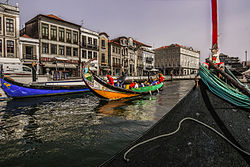Aveiro Municipality
| Aveiro | |||
|---|---|---|---|
| Municipality | |||

Aveiro, known as the Venice of Portugal
|
|||
|
|||
 |
|||
| Coordinates: 40°38′N 8°39′W / 40.633°N 8.650°WCoordinates: 40°38′N 8°39′W / 40.633°N 8.650°W | |||
| Country |
|
||
| Region | Centro | ||
| Subregion | Baixo Vouga | ||
| Intermunic. comm. | Região de Aveiro | ||
| District | Aveiro | ||
| Parishes | 10 | ||
| Government | |||
| • President | José Ribau Esteves (PSD-CDS) | ||
| Area | |||
| • Total | 197.58 km2 (76.29 sq mi) | ||
| Population (2011) | |||
| • Total | 78,455 | ||
| • Density | 400/km2 (1,000/sq mi) | ||
| Time zone | WET/WEST (UTC+0/+1) | ||
| Website | http://www.cm-aveiro.pt | ||
Aveiro (Portuguese pronunciation: [aˈvejɾu] or Portuguese pronunciation: [ɐˈvɐjɾu]) is a city and a municipality in Portugal. In 2011, the population was 78,450, in an area of 197.58 square kilometres (76.29 sq mi): it is the second most populous city in the Centro Region of Portugal (after Coimbra). Along with the neighbouring city of Ílhavo, Aveiro is part of an urban agglomeration that includes 120,000 inhabitants, making it one of the most important populated regions by density in the Centro Region, and primary centre of the Intermunicipal Community of Aveiro and Baixo Vouga. Administratively, the president of the municipal government is José Ribau Esteves (elected by coalition between the Social Democratic Party and the Democratic Social Centre, who governs the ten civil parishes (Portuguese: freguesias).
The presence of human settlement in the territory of Aveiro extends to the period associated with the great dolmens of pre-history, which exist in most of the region.
For a long period Aveiro was important economic link in the production of salt and commercial shipping. It was a centre of salt exploration by the Romans and trade since 26 January 959 (from the testament of Countess Mumadona Dias to the cenóbio of Guimarães). During this testament, Mumadona Dias also highlighted the ancient name for Aveiro, referring to the monastery's lands in Alauario et Salinas, literally, "a gathering place or preserve of birds and of great salt".
The Moors invaded and then held it until the 11th century, after which it became popular with Portuguese royalty.
...
Wikipedia


